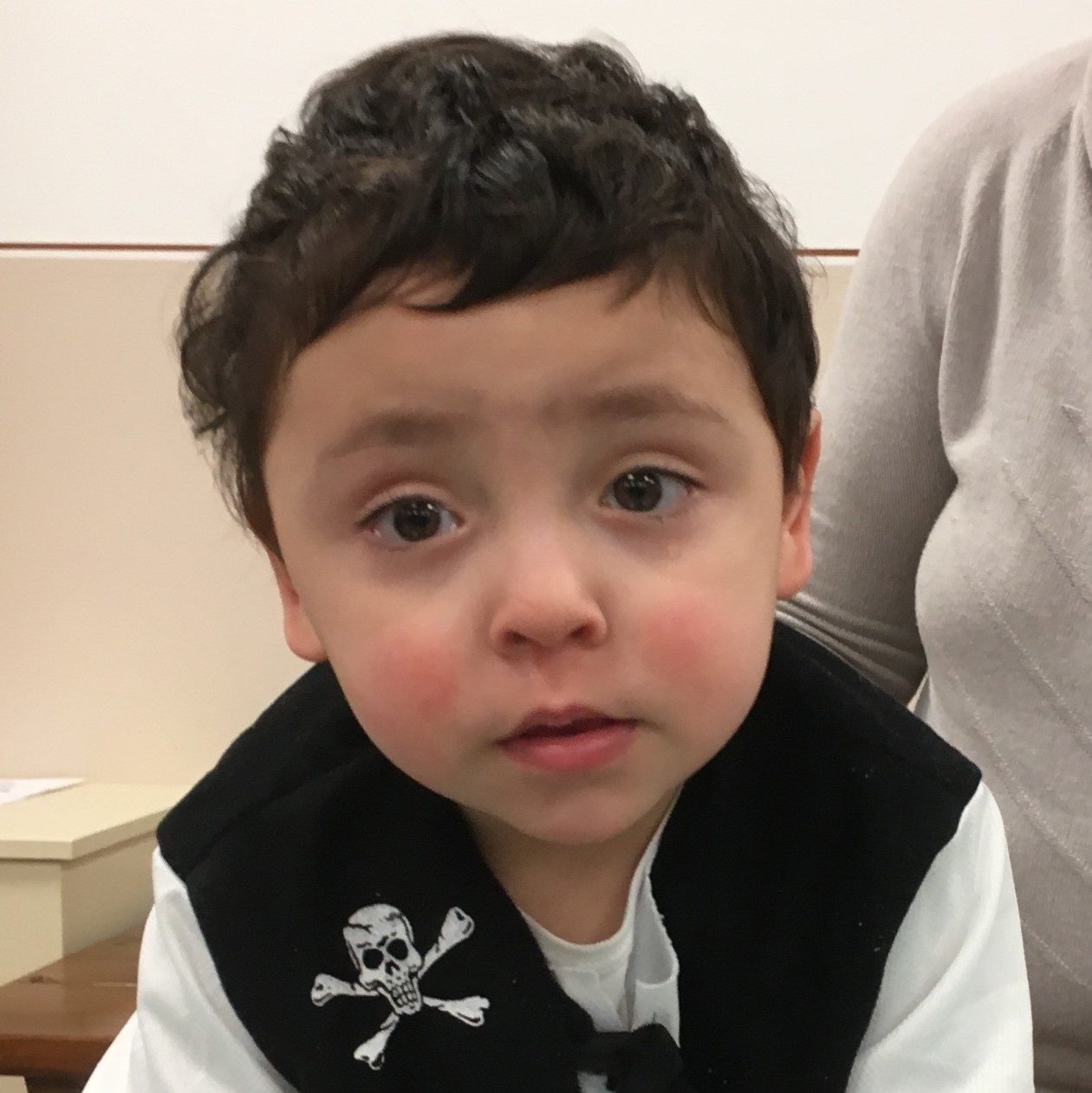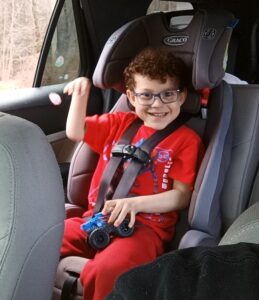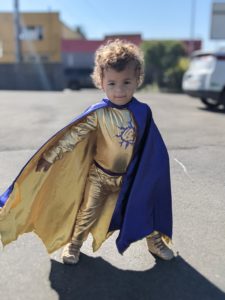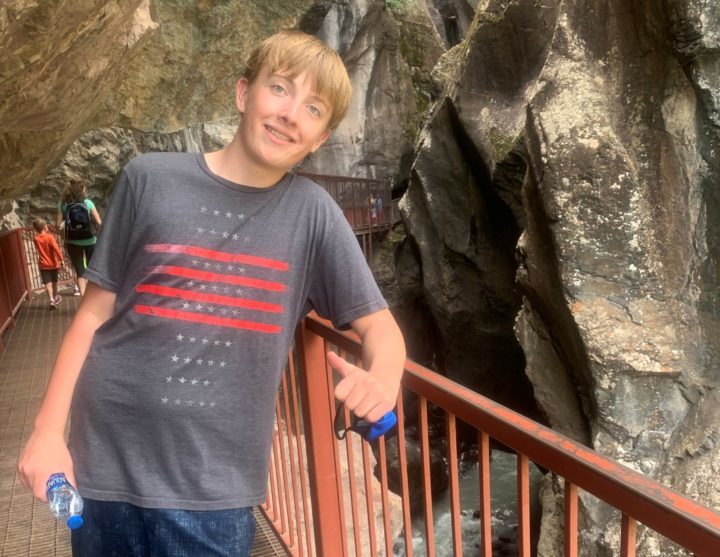Meet Luca — Perinatal Stroke
To read this story in English, click here.
Il nostro Luca è nato nel settembre 2013 con taglio cesareo gemellare d’urgenza. Essendo prematuro (34+2) non è stato ricoverato in TIN ma in patologia neonatale per 12 giorni insieme al fratellino.
Il decorso ospedaliero, a detta dei pediatri, era ottimo e nelle ecografie celebrali, fatte di routine, la “lieve dilatazione di III e IV” ventricolo è parsa loro compatibile con l’età gestazionale.
Le difficoltà dei primi giorni sembravano in linea con la prematurità: difficoltà nel regolare la temperatura (ha passato un giorno in più rispetto al gemello nella culla termica) e successivamente nella suzione dal seno. Nonostante ciò veniamo dimessi con la rassicurazione che entrambi i nostri bambini stanno bene.
Durante il bilancio del secondo mese, la nostra pediatra, nota un ipertono generalizzato e richiede una visita specialistica, la fisiatra poche settimane dopo conferma questa situazione che attribuisce alla prematurità e prescrive cicli di fisioterapia che Luca inizia all’età di 4 mesi. Nel mese di febbraio viene evidenziata un’ipomobilità degli arti di dx ed a settembre, pochi giorni dopo il suo primo compleanno, la fisiatra ci dice che se la causa fosse stata solo la nascita prematura il problema sarebbe rientrato nel primo anno di vita dunque si tratta di danno un permanente. Ci consiglia una visita con la neuropediatra che fissiamo per qualche giorno dopo e che per la prima volta ci parla di evento ischemico consigliandoci una RM che però noi non facciamo subito per paura della sedazione.
Continuiamo le sedute di fisioterapia, le tappe di sviluppo postura-motorio nonostante la diagnosi erano nella norma, a 11 mesi gattonava a 17 camminava da solo. Nella primavera successiva (19/20 mesi) si inizia a notare che mette il piede in punta, l’utilizzo del kinesio taping tiene bene a bada l’equinismo per qualche tempo ma un brusco scatto di crescita durante l’estate peggiora la situazione e ad ottobre viene prescritto il primo tutore. Luca si adatta immediatamente, intanto ha acquisito una buona bimanualità ed a 28 mesi non necessita più di fisioterapia.
A 33 mesi la fisiatra richiede una visita con la neuropsichiatra per via del ritardo del linguaggio, quest’ultima notando anche difficoltà relazionali prescrive sedute di neuropsicomotricità.
Pochi mesi dopo decidiamo di rivolgerci ad un centro di ricerca (Stella Maris) che prima del ricovero per la valutazione fissa una RM (aprile 2016) da cui arriva la conferma di “pregresso evento ischemico focale”.
Poche settimane dopo iniziamo il primo ricovero in day hospital presso la stessa struttura e, con l’occasione, chiediamo alla nostra ulss la cartella clinica del ricovero alla nascita, scopriamo che a 16 e 21 ore dalla nascita Luca aveva avuto due cali della saturazione al 60 e 74% che non ci sono stati riferiti e neppure segnalati nella lettera di dimissioni. Nessun medico ci dirà se in quel momento è avvenuto lo stroke ma, considerando una gravidanza sotto stretto controllo per la gemellarità decorsa in maniera ottimale ed un apgar alla nascita di 9/9, noi genitori nutriamo pochi dubbi.
Dopo due settimane di valutazione allo Stella Maris i medici hanno concluso che lo stroke aveva avuto un impatto, in base alla posizione della lesione, solo sull’aspetto motorio, problemi i relazionali erano sintomo di un rischio evolutivo di spettro autistico. Dopo 7 mesi torniamo per un altro controllo e dopo 10 giorni di ricovero in day hospital confermano lo spettro autistico ed aggiungono che l’ictus ha causato indirettamente anche un lieve ritardo cognitivo. Tra un anno torneremo nella stessa struttura per valutare i suoi progressi, intanto è sottoposto dalla fisiatra a visite di controllo ogni 6 mesi.
Oggi Luca continua a portare il tutore per il piede equino, la bimanualità è ottima ma ovviamente la manina destra non ha la stessa abilità della sinistra, continua le sedute di neuropsicomotricità e da poco ha iniziato delle terapie per la Comunicazione Aumentativa e Alternativa.
Al momento nessuna cura farmacologica è stata somministrata in quanto non ci sono fortunatamente stati, ad ora, episodi epilettici e gli esami della coagulazione non hanno evidenziato alterazioni, non sappiamo infatti cosa ha causato l’ictus.
Nella vita quotidiana il disagio maggiore dovuto allo stroke è senza dubbio il ritardo cognitivo, tuttavia a causa dello spettro autistico è difficile delineare il danno effettivo oltre a quello motorio. Da bravo fighter affronta tante ore di terapia ottenendo meravigliosi risultati che ripagano noi e, soprattutto, lui dell’enorme fatica a cui è sottoposto ogni giorno.
English Translation
Our Luca was born in September 2013 with twin emergency caesarean section. Being premature (34 + 2), he was not hospitalized in TIN but in neonatal disease department for 12 days with the little brother. Paediatric care was excellent, and in routine cognitive ultrasounds, the “slight dilatation of III and IV” ventricles seemed to be compatible with gestational age. The difficulties of the early days seemed in line with premature birth: difficulty regulating the temperature (spent a day longer than the twin brother in the thermal cradle) and then in sucking from the breast.
Nevertheless, when we left the hospital we were reassured that both of our children were fine. During the second month’s visit, our paediatrician noted a general hypertension and required a specialist visit. The physiatrist a few weeks later confirms this situation, attributed to premature birth and prescribes physiotherapy cycles that Luca begins at the age of 4 months.
In February, there was a ‘ipomobility’ of the dx limbs and in September, a few days after his first birthday, the physiatrist told us that if the cause was just premature birth the problem would disappear in the first year of life. So, there was a permanent damage.
We were recommended a visit with the neuro paediatrician a few days later. For the first time, they told us about an ischemic event advising RMI but that we did not do it immediately for fear of sedation. We continued the physiotherapy sessions, posture-motor development stages, despite the diagnosis were normal. At 11 months he crawled and at 17 months he walked alone. In the following spring (19/20 months) we noticed that he pointed his toe in. The use of kinesium taping is useful for equineism for some time, but a sharp increase in growth during the summer worsens the situation.
In October, the first tutor is required. Luca fits right away, meanwhile he has acquired good motor skills of both hands and, at 28 months, he no longer needs physiotherapy. At 33 months, the physiatrist requires a visit to the neuropsychiatrist due to the delay in language, also noticing relational difficulties as neuropsychiatric disorders. A few months later, we decided to turn to a research center (Stella Maris) that, after RMI (April 2016), confirmed “previous ischemic focal event”.
A few weeks later we started the first day hospital hospitalization at the same facility and we ask our clinic, that hospitalized us at birth, our medical documentations from Luca’s birth. We found that at 16 and 21 hours after birth, Luca had had two saturation currents at 60 and 74% that have not been told to us nor even reported in the release letter. No physician will tell us if stroke had occurred at that time but, considering a pregnancy under strict control for the twin-twin an optimal way and an apgar at the birth of 9/9, we, as parents, have little doubt.
After two weeks of evaluation at Stella Maris, doctors concluded that the stroke had an impact, based on the lesion’s position, only on the motor aspect, relational problems were a symptom of an evolving risk of autism spectrum. After 7 months, we went back for another check and, after 10 days of hospitalization, they confirm the autistic spectrum and add that the stroke also indirectly caused a slight cognitive delay. Within a year, we return to the same structure to evaluate Luca’s progress, meanwhile he is subjected to a physiatrist’s visit every 6 months.
Today, Luca goes on using tutor for his foot, mobility of both hands is excellent, but of course the right hand does not have the same flexibility as the left. He regularly undergoes neuropsychiatric sessions and he has just started therapy in Alternative Communication. At present, no pharmacological treatment has been given since there have been no epileptic episodes and clotting examinations have not shown any alterations, so we do not know what caused the stroke. In everyday life, the major discomfort is no doubt the cognitive delay, however due to autism spectrum it is difficult to outline the actual effect beyond the motor damage. A good fighter faces many hours of therapy, achieving wonderful results that reward us, and above all, the enormous fatigue he is subjected to every day.
Help us #MakeMayMatter for kids impacted by stroke! Share this story and #BeAVoice for pediatric stroke.





